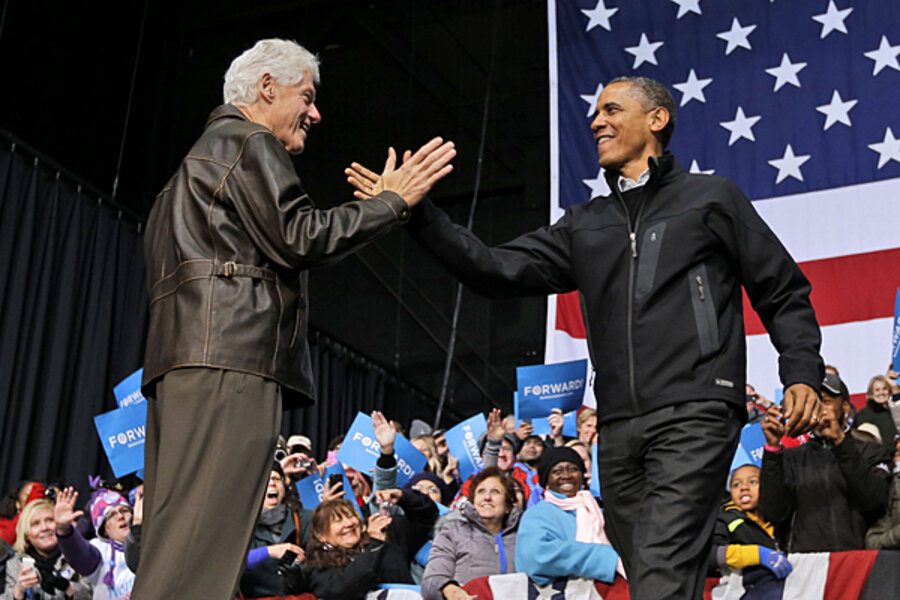Election 2012: Three lessons for Democrats
Loading...
It’s not too early to draw some lessons. Regardless of what happens Tuesday, Democrats should have three big takeaways from the 2012 election.
Lesson One: Democrats Can Own the Future.
Latinos, African-Americans, young people, and women have become the major Democratic voting blocs. That’s good news for Democrats because the first three constitute a growing percentage of the voting population (young people eventually become the entire voting population), while women continue to gain economic ground.
The challenge for Democrats will be to hold these groups in the future. All have been attracted to the Democratic Party in recent years mainly because Republican policies have turned them off – policies like the GOP’s draconian responses to undocumented workers, its eagerness to slash Medicaid and food stamps, its misogynistic approach to abortion, and its demand to cut federal spending on education and student loans.
But if Democrats want to keep their loyalty over the long term, the Party will need to do more than rely on Republican electoral stupidity. After all, the GOP might learn it has to become (or appear to become) more inclusive.
Democrats will need to champion policies especially important to these groups – for example, immigration reforms that take account of how long someone has been in the United States and how much they’ve contributed as workers and citizens; paid family and medical leave for women (as well as men) who must care for their families in emergencies; expansion of the Earned Income Tax Credit, providing larger income supplements to lower-income workers; and income-contingent college loans, allowing them to be repaid as a fixed percentage of full-time jobs over a limited number of years.
All these have the added advantage of being good policies, regardless of their political attractiveness.
Lesson Two: No Matter How “Business-Friendly” Democrats Are, Big Business and Wall Street Will Still go Republican.
No administration in recent memory has done more for business and Wall Street than Obama’s. It bailed out Wall Street (granted, the bailout was initiated under George W. Bush, but most of it – and its execution – happened under Obama) and never demanded in return that the biggest banks modify the mortgages of Americans who were caught by the bursting of the housing bubble. And the Obama Administration still hasn’t brought a single criminal charge against any Wall Street executive.
The Administration also spearheaded a giant stimulus package that kept the economy from falling off a cliff, that generated fat profits for the construction industry, and ultimately pushed stock prices back to where they were before the bubble burst.
The Administration’s Affordable Care Act created 23 million mandated customers for health insurance companies, and billions of dollars worth of new business for America’s largest pharmaceutical companies and hospital chains.
Yet notwithstanding all of this, big business and Wall Street threw in their lot with Mitt Romney and the GOP.
This isn’t to say corporate executives and Wall Street traders will always side exclusively with Republicans. Typically, they’ll hedge their bets – giving Democrats just enough campaign money to keep them in line.
But they’ll always donate more to the GOP, because the Republican Party will always outdo Democrats when it comes to making corporate executives and Wall Street traders richer by lowering their taxes, subsidizing their businesses, and abandoning regulations that stand in the way of bigger profits.
The lesson is so-called “business friendly” policies that translate into more money for top executives don’t pay off for Democrats. Democrats should push economic policies that are good for the middle class, and for everyone aspiring to join it.
They should also get firmly behind campaign finance reforms that limit the ability of big business and Wall Street to corrupt the political process.
Lesson Three: Democrats Need the White Male Working Class, and the White Male Working Class Should Need the Democrats
To create an enduring coalition, Democrats also need the white working class. They used to have it. In 1960, 57 percent of blue-collar whites identified themselves as Democrats, and only 26 percent as Republicans.
But that support began to erode dramatically. By 1980, 57 percent of the white working class voted for Reagan over Carter; in 1984, 65 percent backed Reagan over Mondale; in 1988 60 percent voted for Bush over Dukakis. And even though Bill Clinton managed to win back white working-class women, the shift of white men to the GOP continued.
It’s tempting to point to race as the major contributor. To be sure, southern whites began deserting the Democratic Party after the Civil Rights Act of 1964. And the GOP has lost no opportunity to play the race card – whether in the “Willie Horton” ads of 1988, or the more subtle racial message of “state’s rights” in 2012.
But that explanation leaves out the bigger story.
The wages of white men without college degrees began falling in the late 1970s because of globalization and technological changes that corporations were all too eager to take advantage of.
Today, the typical white male worker without a college degree earns less than he did thirty-five years ago, adjusted for inflation.
Yet the Democratic Party has done little to reverse this trend. (It pains me to level this charge because I was Secretary of Labor in the 1990s and didn’t fight hard enough.)
Democrats could have enacted labor law reforms that made it easier to form and preserve labor unions – which in the 1950s and 1960s gave the working class bargaining power to get a fair share of the profits. Democrats could have pushed for a nationwide system of productivity bargains, as in Germany, through which employees get a share of the gains from productivity growth.
They could have insisted all trade-opening treaties require that America’s trading partners have a minimum wage equal to half their median wage — and have set America’s own minimum wage to this standard. And Democrats could have reduced taxes on the middle and working class, and raised them on the rich.
By turning its back on white working-class men the Democratic Party created a political vacuum Republicans have been all too eager to fill.
Whether through racism, xenophobia, or homophobia, or by means of right-wing evangelical Protestantism, the GOP have found scapegoats. Blacks, immigrants, gays, and women seeking abortions aren’t responsible for the declining real wages of white men without college degrees, of course, but they are convenient targets of their anger.
The overall lesson is simple, and Democrats used to know it. As Harry Truman put it in 1948, we need a government “that will work in the interests of the common people and not in the interests of the men who have all the money.”
That lesson needs to be relearned.






